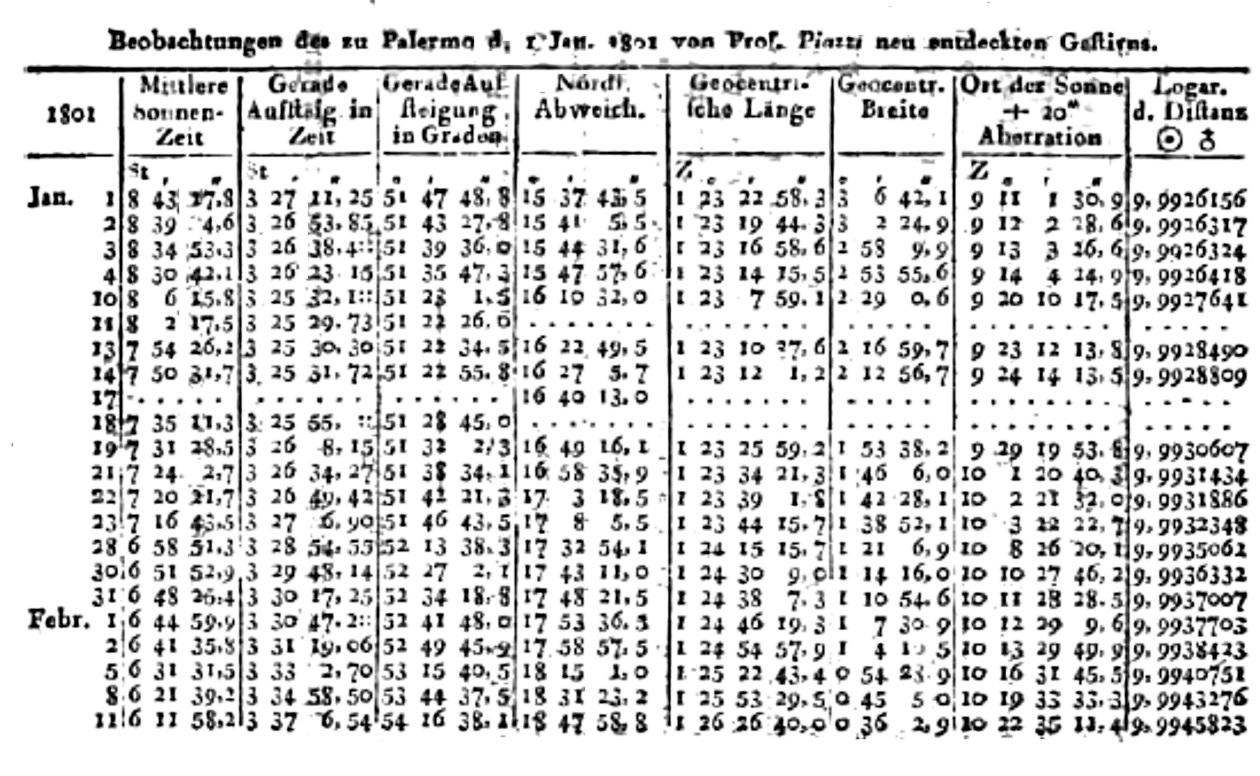Piazzi's Ceres Dataset of 1801
Jump to navigation
Jump to search
A Piazzi's Ceres Dataset of 1801 is a orbital dataset for Ceres body collected by Giuseppe Piazzi.
- Example(s):
- …
- Counter-Example(s):
- See: Linear Least-Squares Regression.
References
2013
2005
- http://dawn.jpl.nasa.gov/DawnCommunity/flashbacks/fb_04.asp
- QUOTE: It was a dark and starry night of New Year’s Day, 1801, and Giuseppe Piazzi, an Italian monk, was at work in his observatory on the island of Sicily. As a member of the Celestial Police, a group of astronomers looking for Kepler’s missing planet between Jupiter and Mars, he was compiling an accurate catalog of known stars in the Taurus constellation. He was verifying some of his predecessors’ work when he saw a tiny point of light close by. At first he thought it was just a dim star that had not been included on his chart, so he checked for it the next night, but it had moved! He continued to note its position changes on January 3 and 4. … Cloudy weather and illness prevented Piazzi’s regular observation of the skies on some January nights, but by January 24, it was evident that he understood what he had discovered. … Piazzi’s six weeks of observations in January and February, however, did not provide enough information to calculate the object’s orbit by any known methods. A reliable orbit was essential to establishing the authenticity of any newly sighted object, because knowing the orbit would enable astronomers to predict where they might find the object when they wished to investigate it more extensively.
1999
- https://www.math.rutgers.edu/~cherlin/History/Papers1999/weiss.html
- QUOTE: When Uranus was discovered in 1781, it was found to fit the Titius-Bode law. The only unexplained number left in the series would correspond to a planet between Mars and Jupiter. In 1800, an informal society was formed to find this missing planet, and Zach, the director of the Seeberg observatory and editor of the Monatliche Correspondenz, the main German astronomical periodical at the time, used his periodical to gain support for this effort [8,10]. Then,on January 1, 1801, the Italian astronomer Joseph Piazzi discovered a planetoid, working from an observatory in Palermo, Italy. This object, which he christened Ceres, was moving in the constellation Taurus. Astronomers were only able to observe the planetoid for 41 days, during which its orbit swept out an angle of only 9 degrees. Ceres was then lost to sight when its light vanished in the rays of the sun, and the astronomers could no longer find it. There was now a challenge of calculating Ceres' orbit using only the observations Piazzi made, so that astronomers would be able to sight Ceres when it reemerged. [1,5,6,8,10]
Zach published Piazzi's observations of Ceres in June of 1801. Most of the leading astronomers in Europe already knew of these observations when they were published, and were scrambling to determine its orbit. [1,6]
- QUOTE: When Uranus was discovered in 1781, it was found to fit the Titius-Bode law. The only unexplained number left in the series would correspond to a planet between Mars and Jupiter. In 1800, an informal society was formed to find this missing planet, and Zach, the director of the Seeberg observatory and editor of the Monatliche Correspondenz, the main German astronomical periodical at the time, used his periodical to gain support for this effort [8,10]. Then,on January 1, 1801, the Italian astronomer Joseph Piazzi discovered a planetoid, working from an observatory in Palermo, Italy. This object, which he christened Ceres, was moving in the constellation Taurus. Astronomers were only able to observe the planetoid for 41 days, during which its orbit swept out an angle of only 9 degrees. Ceres was then lost to sight when its light vanished in the rays of the sun, and the astronomers could no longer find it. There was now a challenge of calculating Ceres' orbit using only the observations Piazzi made, so that astronomers would be able to sight Ceres when it reemerged. [1,5,6,8,10]
